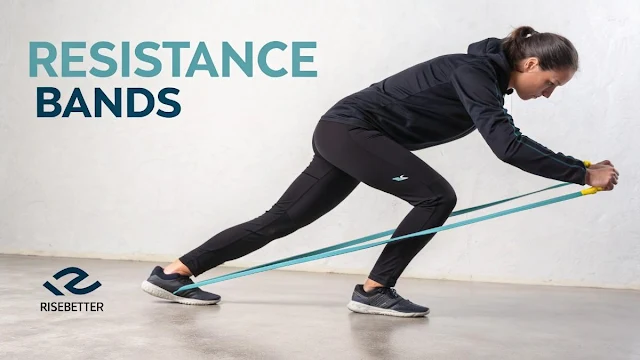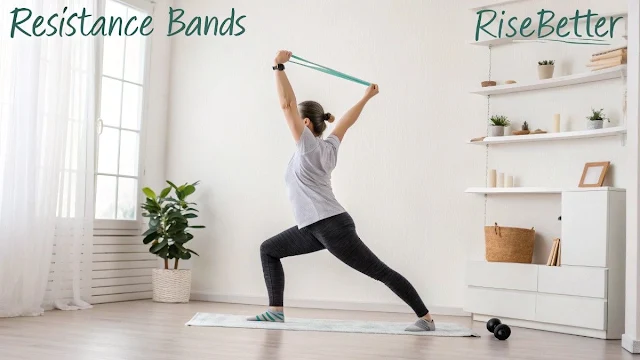Resistance bands should be your go to if you are seeking a
low-cost, practical, and extreme effective all body training approach. Whether
you are working from home, on the go, or just exhausted of weights, these
adaptable tools could help you develop strength, increase flexibility and tone
muscles—no gym pass required. beginner suggestions, professional exercises and
why this training approach truly works will all be shown in this tutorial on
how to do full-bodied workouts using resistance bands.
Resistant bands—what are they?
Intended to increase tension on your movements, resistance
bands are flexible bands made of rubber or latex. This is opposition that
assists to develop stability, endurance, and muscle power. They vary in
type—flat bands, loop bands, tube bands with handles—and in resistance level
from light to heavy.
Resistant bands keep consistent pressure on your motion, in
contrast to free weights. This results in improved muscle
involvement—particularly in the stabilizers typically ignored.
Advantages of using resistance bands for training
Research shows many benefits of total body strength training
with resistance bands:
- Enhances muscle tone and strength without the damage of severe weights
- Especially in seniors, improves flexibility and range of motion
- By encouraging better form and control, it helps to lower the chances of injury
- Great for house exercises, travelling, or little area training.
- From beginners to athletes, appropriate for every level of fitness.
Published in the Journal of Strength and Conditioning
Research, a study found that especially when reps and form are controlled,
resistance bands can as much stimulate muscle development as traditional
weightlifting presented.
How resistance bands help for full body training
To perform full body resistance band exercises, combine
compound actions—those that use several muscle group—with functional movements
mimicking daily activities.
Resistance bands provide variable resistance—that is, the
more you stretch the band, the more it strengthens. This engages muscles all
over the range of motion, so resulting are better engagement and outcomes.
Full body resistance band exercise plan
Using resistance bands, let tooled a balanced and
efficient full body workout:
1: Leg & Glute Resistance Band Squats
- Step on the band with feet shoulder width apart.
- Hold the band should secured at shoulder level.
- Squat to keep toes in line with knees.
2. Standing Barbell Rows (Back & Biceps)
- Anchor the band around any door or pole.
- Hold the handles and step back for tension.
- Pull shoulders toward body, squeeze shoulder blades.
3. With head lift (shoulders)
- Stand on the band and clutch the handles
- Slowly lower, then blow gently overhead with both arms
4. Chest Press (Chest; Triceps
- Anchor the band behind you (e.g., around a pole) rather than in front of you.
- Step forward and push arms straight from chest
5. Core Rotation (abs and obliques)
- Anchor of the band in chest level.
- With both hands, twist torso and hold one handle.
- Use core muscles throughout
6. Glute Bridge using Band (Glutes & Hamstrings)
- Over your knees, put a loop band
- With feet flat, lie on your back.
- Raise hips and squeeze glutes on top
7. Outer Thighs & Hips Lateral Band Walking.
- Place loop band above the knee.
- Half squat.
- Step side to side and keep the tension.
Maximizing Your Resistance Band Workout Tips
These are some sensible suggestions to get the most of your
exercises:
1: Start light, advance slowly: Begin with a lighter band to
master correct form.
2: Control every repetition: Avoid letting the band
"snap" back; slow, deliberate actions are essential.
3. Run resistance levels: Combine different bands or double
them up for variety.
4. Combine squats with presses or rows with lunges for
efficiency.
5. Use bands after your workout to increase flexibility.
Weekly Full-bodied Resistance Band Plan Sample
Here’s a professional and well-structured table for your weekly resistance band training plan.
7-Day Resistance Band Workout Plan
| Day | Focus Area | Targeted Training |
|---|---|---|
| Monday | Upper Body Strength | Resistance band rows, chest press, and overhead shoulder press to build upper body strength and improve posture. |
| Tuesday | Lower Body Toning | Squats with band tension, glute bridges, and lateral band walks for glutes, thighs, and hip mobility. |
| Wednesday | Core & Active Recovery | Core banded twists for obliques, followed by stretching to promote recovery and flexibility. |
| Thursday | Full-Body Circuit Burn | Perform a dynamic circuit of upper, lower, and core resistance band exercises with minimal rest. |
| Friday | Upper Body Power | Focus on slow, controlled reps of rows and presses using moderate resistance to increase strength and control. |
| Saturday | Lower Body Mobility & Flexibility | Use bands for deep lower-body stretches, hip openers, and light squats to enhance mobility. |
| Sunday | Recovery Day | Optional: Take a gentle walk or do yoga with light band stretching to support active recovery. |
Final Thoughts: Small tool, great impact.
Although they seem simple, resistance bands deliver quite a
blow in terms of total body workouts. Affordable, flexible, and strong enough
to shape lean muscle, increase mobility, and boost general fitness. These
flexible bands should be part of your training kit whether you are a novice or
an experienced athlete.
So, grab a band, find your rhythm, and let your body move
freely—no heavy equipment needed.
FAQs
Q1. do resistance bands effective help to increase strength?
A: Absolutely! Research indicate that resistance bands could stimulate
muscles much like free weights would. If used correctly in terms of form and
intensity, they are great for muscle development and definition.
Q. Are there resistance bands beginners can use?
A: For sure. Perfect for beginners, resistance bands enable
slow muscle development and are nonimpact.
Q3. How many times a week should I train with resistance
bands?
A: Seek for 3–5 times per week of balanced outcomes by
combining core, upper body, and lower body exercises.
Q4. Which are superior: weights or resistance bands?
A: Either one offers advantages. Bands are ideal for home
exercises, easy on joints and mobile. Weights give constant resistance and may
be used with bands for more challenge.
Q 5: Do resistance bands assist in weight reduction?
A: Particularly when mixed with a balanced diet and cardio
workout. By developing muscle, resistance training helps to increase metabolism
and assist fat loss.
Related Posts
- Stretching Secrets: Why Warm-Ups Matter
- How to Boost Your Cardio in 30 Minutes a Day
- The Role of Protein in Fat Loss: Myths vs. Facts
👉 Want more? Check out our workout routines and fitness challenges to stay active.









0 Comments